When Vincent van Gogh wanted to capture the wonder of creation on a canvas he painted sunflowers. The Dutch artist is not alone in appreciating this popular bloom. Everyone loves a sunflower, both pollinators and gardeners alike. Having these larger-than-life plants blossom in your garden during late summer and early autumn is a joy to behold. Unfortunately, although they are relatively easy to grow, we all make a few avoidable mistakes in our impatience to turn our yards into a riot of yellow and green.
Sunflowers can cheer the gloomiest disposition and brighten up the dullest day, but to do that they need to grow properly in the first place. Planting them in the wrong location, in poor conditions, overwatering, and not giving them adequate protection from the elements and the birds are just a few reasons your sunflowers might never reach their true potential. However, putting things right is an easy fix. To ensure your seeds turn into bright and otherworldly flowers that reach for the heavens while transforming the earth, here’s what you should know.
Forgetting they need a lot of sun

Sunflowers are more associated with the big ball of fire in the sky more than any other plant. The clue is in the name! In Greek mythology, the sun god Apollo turned his lover Clytie into a sunflower in an act of rage. It’s said that sunflowers follow the journey of the sun across the sky from dawn to dusk because Clytie is still obsessed with her old flame. However, despite its time-honored association with the sun, many people still make the cardinal mistake of planting these flowers in areas where there is little to no sunlight. Big mistake! If they are to grow to their full potential we’re talking about 6-8 hours of the golden stuff all day, every day.
When it comes to planting your sunflower seeds, ensure you pick a location where the soil is fertile and well-drained, and which captures a lot of sun. They tend to grow a lot taller when planted in the ground because there are a lot more natural nutrients in the soil to meet their big appetites. However, you can also grow them in a pot as long as it’s placed in a sunny area of your yard. When planting in the ground, simply rake the earth, and sow the seeds in drills 1 inch deep. Top them up with soil, and with a little watering and plenty of sun, they’ll do what they do best – grow! Make sure to keep an eye on the slugs and snails when the plants are in their infancy.
Giving them too much water

Alongside the sun’s rays, the other basic building block of life is water. And when the temperatures soar and the very air appears dehydrated it’s easy to kill your sunflowers with kindness through overwatering. However, it’s important to resist the urge to keep topping them up, regardless of the moisture levels in the soil because it does them no favors. Although they need their fair share of water and do not respond well to drying out, they are plants that do not tolerate overwatering as their roots are prone to rot.
Watering your sunflowers is a balancing act but it’s not a particularly difficult one to master. If the topsoil appears dry, it’s time to give them a gentle soaking. Their deep roots will be grateful but don’t make the mistake that a daily drowning will help them grow better. As they grow, an inch of water every seven days until the soil is moist should be adequate. When the seeds are germinating they require even less water. If you want the sort of giant sunflowers that will take your neighbors’ breath away, top the soil up with a nitrogen-based fertilizer every two weeks, and before they flower, try a potash-rich tomato feed.
Not giving them enough room to grow
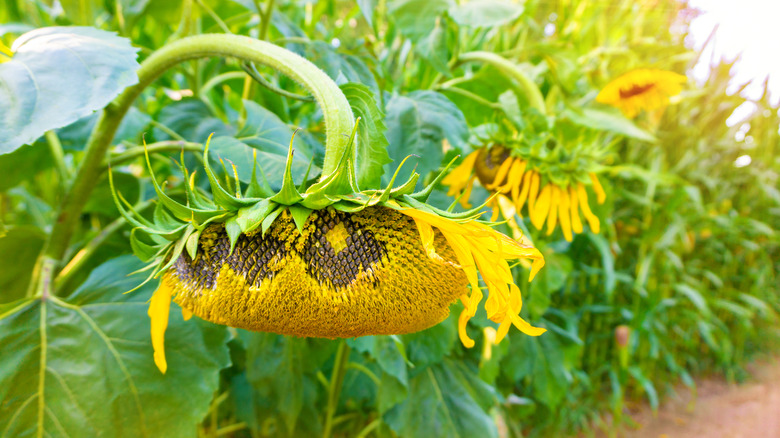
nieriss/Shutterstock
So your sunflowers have got enough sunlight and you’re not overwatering them, what could go wrong? Well, just as humans respond well to uncrowded and spacious conditions, so too do plants. If they haven’t got enough space to kick back and stretch their metaphorical legs, sunflowers will grow up all bent out of shape, or not at all. It’s important to sow the seeds at the right depth and allow adequate space between the sunflowers to prevent disease and poor growth. Throwing loads of seeds in the soil and hoping for the best won’t end well.
The general rule of thumb is to sow seeds about one inch deep with about 6-8 inches between them. It’s advisable to place a little snail bait near the seeds to protect them and perhaps put a net cover in place to keep the birds away as the seedlings grow. However, if you’re looking to grow towering sunflowers with exceptionally big seed heads, the recommended space is 20 inches. If the space in your yard is at a premium but you still want to grow giant sunflowers, plant clusters of 5-6 seeds. When the plants have reached the three-inch mark, thin all but the healthiest 3 or 4. When the remainder grow to a foot tall, thin until only two remain, and when they grow to two feet, choose the one you want to keep.
Not planting them at the right time
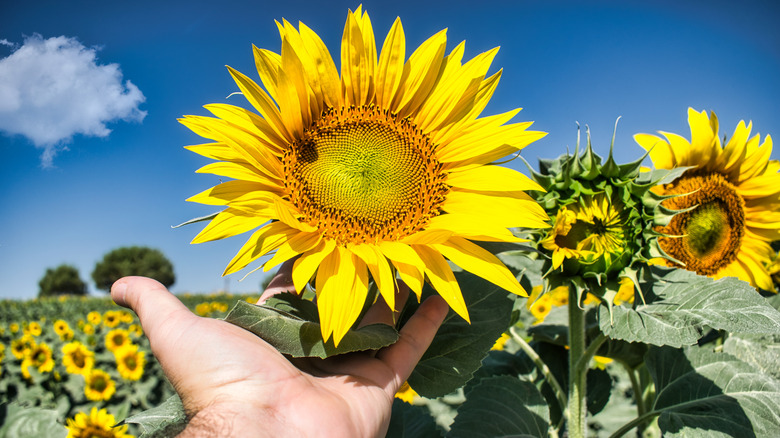
David Andres Gurierrez/Getty Images
Timing is everything in all walks of life and planting sunflowers is no different. They can take anywhere from 70 to 95 days from planting to reach their full potential. Yet if you plant them too early or too late, the seeds simply will not germinate or their growing time will be cut short by autumn’s chill. Growing sunflowers outdoors in your yard is by far the easiest and most effective option. If sowing directly into your garden is not an option, use a pot. It’s important to wait until spring has finally liberated itself from the last remnants of frost and the soil has warmed sufficiently.
Temperatures of 60 to 75 degrees are optimal for successful germination. In the southern states of the U.S. anytime early April or mid-March at a push will work. And in the northern states and Canada, some point between April and June will be acceptable. If the seeds are still in the ground they can survive a late frost, but if it’s forecast, protect the soil with a frost cloth. A long hot summer is a sunflower’s best friend and If you are planting later in the season always calculate the number of days it will have to grow before the first frost falls.
Planting them in grass
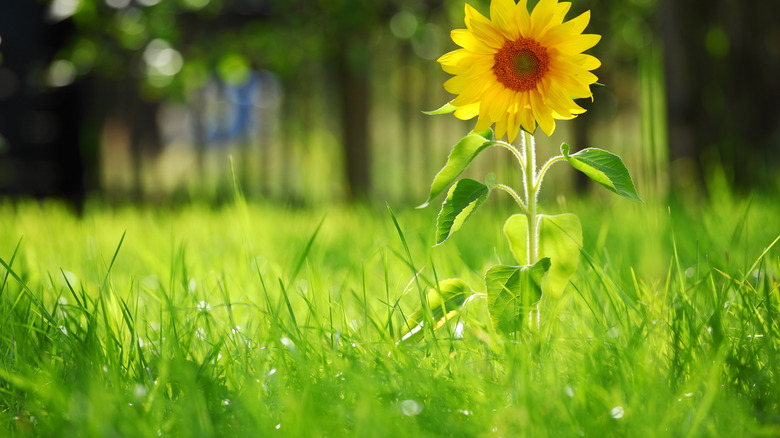
Konradlew/Getty Images
If you’ve ever looked lovingly at your lawn and thought how much lovelier it would look with a few strategically placed sunflowers, you’re not alone. However, although it might have a pleasing aesthetic, in reality, it’s a no-go. The trouble lies with all the grass seeds that the sunflower seeds will have to compete with just to have a fighting chance of survival. The odds are stacked against them in such an environment and it would be an unfair competition.
If you’re still adamant that you want a lush and rolling green backdrop to your sunflowers, a workable solution is to strip two square feet of turf away for each sunflower. After you’ve planted the seeds a layer of organic mulch can help lock in the moisture and make it look more pleasing to the eye. The mulch will also help prevent any weeds from growing around the base of your sunflower which will deprive it of vital nutrients.
Not protecting them from birds and squirrels
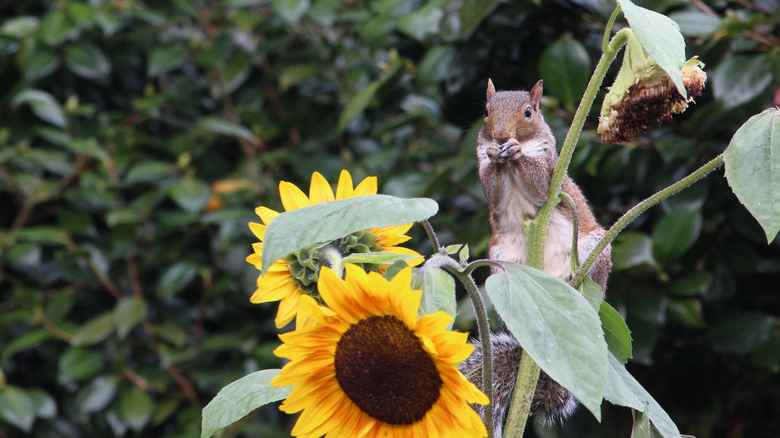
Elizabeth Foster/Shutterstock
When the plants are small, it’s important to remain vigilant about the potential threat to sunflowers that slugs and snails pose, but birds and squirrels are a different matter. We may want to encourage an abundance of wildlife in our yards but there needs to be boundaries. Although in winter you may end up feeding the birds the seeds from your sunflowers you don’t want their blooming glory ravaged before their time in the sun is done. Additionally, many people harvest the seeds from the heads for replanting or roasting. And if our little feathered friends and their bushy-tailed sidekicks are left unchecked there may not be many left when it comes to harvesting them.
Teaching birds and squirrels to leave sunflowers alone or wait their turn doesn’t have to be painful and can be done quite humanely. Placing a light netting over the heads of the sunflowers is a tried and tested tactic when worked in conjunction with various sprays and repellants to deter birds. A more simple option is to cover the head with a brown paper bag. However, both options look plum ugly and defeat the purpose of having sunflowers in the first place. It is only really viable if you are preserving the heads for floral displays. A better tactic to frighten away birds is to hang light reflective and swaying CDs near the plant or hang tinsel on it. Keeping squirrels at bay is slightly easier. Encasing the stalk with aluminum foil will prevent the squirrel from getting a purchase. Alternatively, you can create a sharp and jagged terrain at the base of the plant to make it unwise for the squirrel to cross.
Not giving them enough support
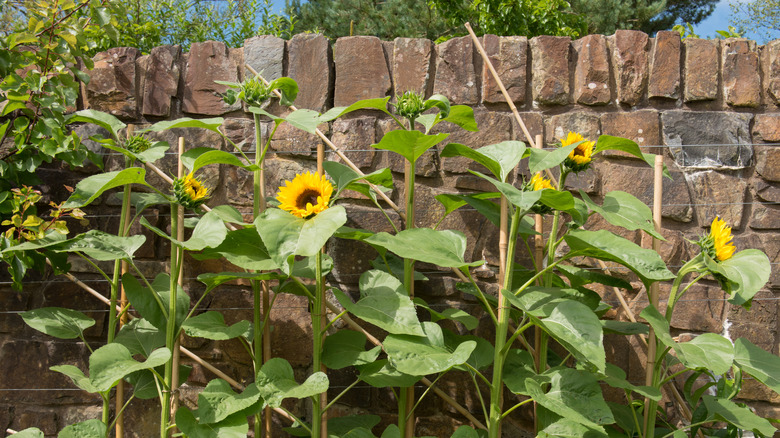
Peter Turner Photography/Shutterstock
Sunflowers are renowned for their big seed heads. Yet all that weight is a heavy burden to carry and sometimes their slender stems are not up to the task. If you’re hoping to grow some pretty epic sunflowers you’ll need a bamboo cane or two to prop them up as they grow. Otherwise, they’ll end up looking like they’re hanging their heads in shame. In the worst-case scenario, the stem will break and they’ll flop to the ground. If you don’t want all your hard work undone at the moment it matters most, ensure you give nature a helping hand and offer your sunflowers plenty of support as they grow.
As they begin to properly announce themselves to the world, tie the sunflower stem to a bamboo cane with some garden twine. Ensure the knot is tied on the support and not the sunflower. The cane should keep the sunflower firmly in place and prevent it from flopping but don’t make the knot too tight or you could accidentally snap the stem. As the plant grows it will require more knots. If you’re planning on growing a supersize sunflower you’ll probably need to tie a couple of canes together for extra support. This system definitely pays off and helps grow flowers capable of kissing the sky. In 2024, Germany’s Hans-Peter Schiffer used a lot of cane and a multi-level scaffolding platform to grow a record-breaking sunflower that stood at just over 30 feet high.
Planting them in vegetable patches
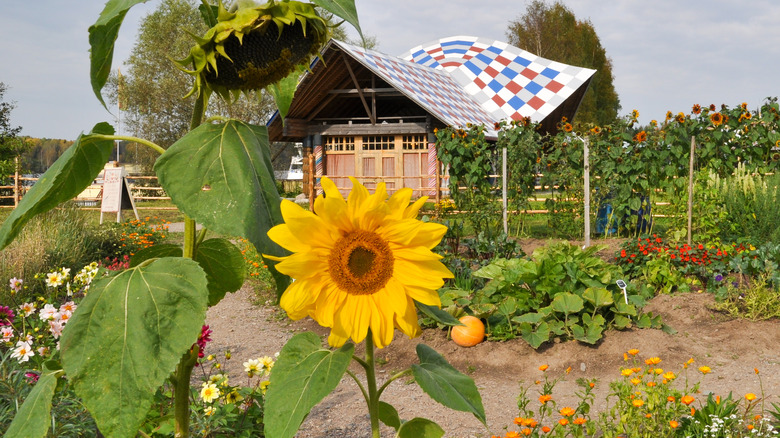
Ingunn B. Haslekaas/Getty Images
Sunflowers have such a cheery disposition it’s almost impossible to imagine them having any ill effect. Yet as anyone who’s ever planted them in vegetable patches knows, they don’t exactly get on well with potatoes and green beans. It’s a common mistake to want to brighten up the corner of your yard where you grow edibles by planting a sunflower. There’s also the temptation to sow them amongst the veg because their stems are perfect for climbing beans. However, as an allelopathic plant, the sunflower only survives by emitting phenolic compounds that are toxic to other plants and can stunt their growth. This means that you’ll have healthy sunflowers but a poor crop of potatoes and beans.
Sunflowers are so effective at acting as a natural weedkiller, that researchers believe they can be used to make organic herbicides. Yet you don’t want to accidentally be the architect of your vegetable patch’s downfall, so plant the sunflowers elsewhere. If you’re worried about your sunflowers having an adverse effect on other plants, fear not! Many are immune to the sunflower’s toxicity and actually flourish in their company. They include mint, thyme, roses, carnations, iris, lemon balm, coneflower, black-eyed Susan, lupines, clematis, daylilies, and dahlia.
Starting the seed indoors
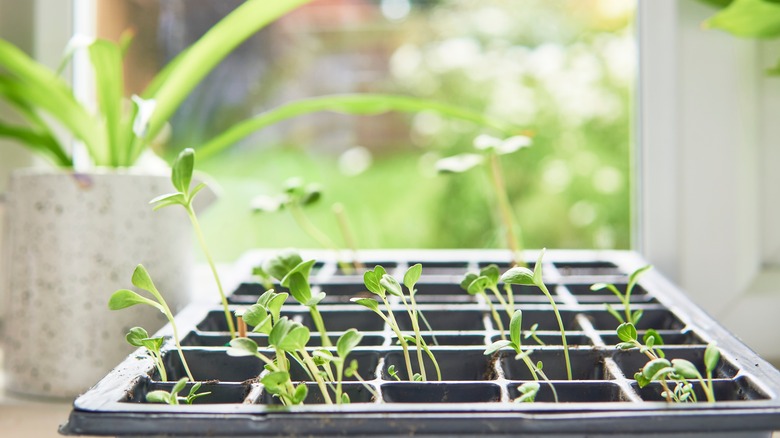
AnyaWhy/Shutterstock
It’s often tempting to start a sunflower seed indoors in spring for a number of reasons. You can keep them protected from the elements, safe from slugs and snails, and watch over them as they grow. And when your sunflower seedlings are strong and healthy enough to finally leave home and survive on their own, you can simply replant them in the garden. Growing a sunflower in a pot and then successfully planting it outdoors once the threat of frost has passed seems too good to be true, and that’s because a lot of the time it is. Sunflowers grow well indoors due to a warm and protected environment but that does not mean all that healthy growth will effortlessly translate outdoors.
Their tenderness from leading a sheltered life makes them susceptible to the harsh conditions of nature and it’s a big shock to their system when they are transplanted. Additionally, their fast growth means their roots can get stunted in a pot. When the plant is then put in the ground it often has difficulty establishing itself. It’s always best to sow sunflower seeds directly into the ground, but if you do opt to start the seed indoors, you need to transplant it within three weeks of planting or when its first true leaves are first visible, otherwise, things could go wrong.
Not rotating where you plant them
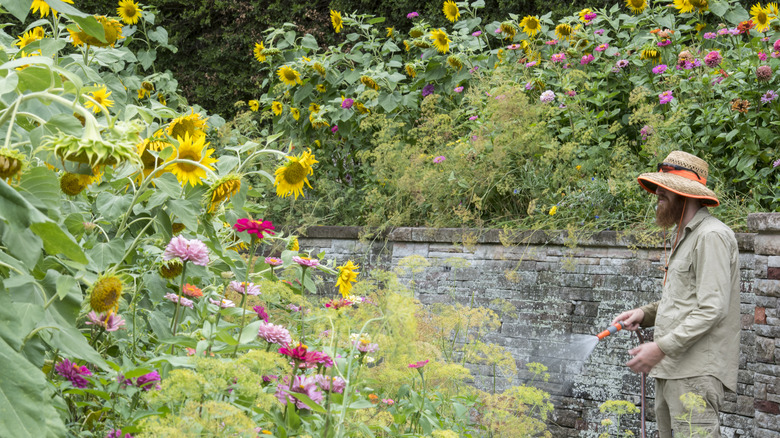
James D. Morgan/Getty Images
When you’ve finally found a patch in your yard where sunflowers flourish it’s tempting to fall into the trap of keeping them in the same spot year in and year out. After all, if it ain’t broken, why fix it? The trouble is if you don’t rotate your planting pattern, the phenolic compounds that adult sunflowers release to kill the competition will one day begin to have a negative effect on their own seedlings. Where there was once a healthy and towering crop, you’ll have a miserable and stunted lot who would have been better off being rotated many moons ago.
Regular rotations help the soil clear itself from a variety of harmful toxins. Sunflowers are also at risk from the fungus sclerotinia, which can live for long periods in the soil. So always pick a new spot for your sunflowers every year, where there’s plenty of sun, the soil is rich and well-drained and you can begin anew. You should let a few years pass (at least three) before you plant sunflowers in the same spot again. It will help keep things interesting and the soil healthy.
Forgetting to deadhead them
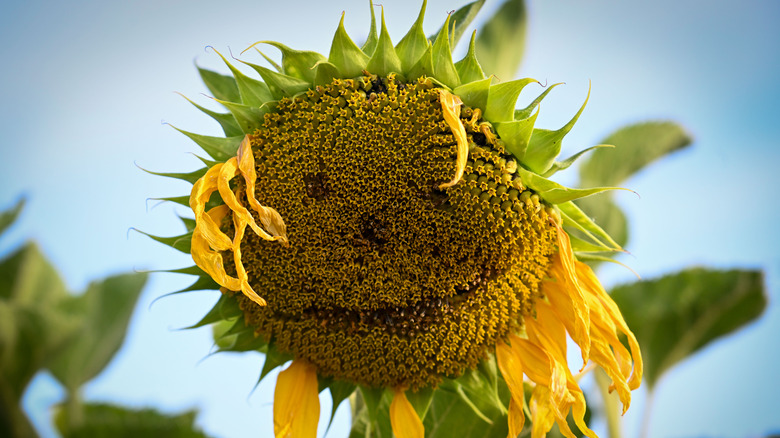
Finnbarr Webster/Getty Images
Deadheading a sunflower sounds quite brutal. In reality, it can be a rather tedious affair and viewed by many as unnecessary. However, if you want your sunflowers to carry on flowering and looking gorgeous during the onset of autumn, it’s an absolute must. Deadheading is all about removing any blooms that look wilted, tired, and colorless. If they’re hanging their heads in defeat, it’s time to give them the snip and let a new bloom take their place. The science is simple. By cutting away decaying matter, the plant can channel all its energies into the process of creating new flowers and looking beautiful.
Horticultural Consultant Colin Skelly told Horticulture Magazine, “Large single-headed sunflowers will not need deadheading, but many sunflowers will typically have many smaller flowers that will benefit after the first, often larger, flowers have bloomed. Deadheading will extend the season and provide many smaller flower heads for seed saving or wildlife.”Simply take some shears and cut the stem below the dying bloom and just above the first set of healthy leaves. If you notice any leaves that look lackluster, remove them as well. Dispose of the fallen flower heads and wait for the new ones to arrive. It’s a bulletproof tactic to keep your sunflowers looking as fresh as daisies all summer long.



